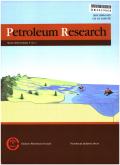用共晶铋合金塞减轻气体迁移
IF 4
Q1 Earth and Planetary Sciences
引用次数: 0
摘要
天然气运移是油井中需要解决的一个重要问题,特别是在那些将要废弃的油井中。阻止气体泄漏并不是一项简单的任务,在安装水泥塞时尤其有害,因为运移的气体会破坏所述水泥塞的完整性。在这种情况下,考虑到最近对金属塞的关注,我们研究了铋塞关闭气体泄漏的能力。用于形成堵头的铋合金需要在井下熔化,因此,如果发生泄漏,其适当的凝固可能会受到影响。我们测试了两种铋合金——共晶铋-锡和共晶铋-锡-铟——以及两种管道——丙烯酸和钢的密封能力。结果表明:只要合金为共晶合金,铋塞就能封闭管内空间;否则,如果合金仅接近共晶,则会产生通道,有效地允许泄漏仍在继续。这两种共晶合金的密封性能都得到了验证,尽管也观察到塞芯内部仍然存在空隙,可能会破坏其机械性能。此外,我们还观察到,缓慢和可控的冷却方法减少了内部空隙的体积,从而减轻了由迁移气体引起的桥塞退化。进一步的工作应该验证这些空隙如何影响桥塞的水力剪切粘结强度。从显微组织的角度来看,凝固冷却速度对材料的晶粒尺寸起着关键作用,晶粒尺寸对合金的显微组织和力学性能有重要影响。考虑到本工作中讨论的结果,我们建议在泄漏井中采用双堵头方法:第一个共晶堵头将以其强度为代价关闭泄漏,然后第二个共晶或非共晶堵头将放置在无泄漏处,确保所需的强度和密封性要求。该研究进一步强调了铋合金的潜力,通过减少气体运移问题,可以提高桥塞弃井作业的安全性和效率。本文章由计算机程序翻译,如有差异,请以英文原文为准。
Mitigating gas migration with eutectic bismuth alloy plugs
Gas migration is an important concern to address in oil wells, especially in those that are to be abandoned. Stopping a gas leakage is not a simple task, and this can be particularly detrimental when setting a cement plug, as the migrated gas can undermine the integrity of said plug. In this context, and considering the recent attention given to metal plugs, we investigate the capability of bismuth plugs in shutting off gas leakages. The bismuth alloy employed to form the plug is to be melted downhole, and thus its proper solidification may be compromised if a leakage is underway. We test the sealing capability of two bismuth alloys – the eutectic bismuth-tin and the eutectic bismuth-tin-indium – along with two pipes – acrylic and steel. Results indicate that the bismuth plug can seal off the inner space of the pipe as long as the alloy used is eutectic; otherwise, a channel is created if the alloy is only near eutectic, effectively permitting that the leakage still continues. This sealing capability has been verified for both eutectic alloys tested, although it was also observed that voids are still present within the plugs themselves, potentially undermining their mechanical properties. Furthermore, we also observed that a slow and controlled cooling approach reduces the volume of inner voids, thus mitigating the plug degradation caused by the migrating gas. Further work should verify how these voids impact the hydraulic shear bond strength of the plug. From a microstructural perspective, it seemed that the solidification cooling rate plays a key role in the grain size of the material, which significantly impacts the microstructure of the alloy and, consequently, its mechanical properties. Considering the findings discussed in this work, we recommend that a two-plug approach is employed in leaking wells: a first, eutectic plug would shut down the leakage at the cost of its strength, and then a second – eutectic or non-eutectic – plug would be placed under no leakage ensuring the desired strength and sealability requirements. This study further highlights the potential of bismuth alloys to enhance safety and efficiency in plug and abandonment (P&A) operations by mitigating gas migration issues.
求助全文
通过发布文献求助,成功后即可免费获取论文全文。
去求助
来源期刊

Petroleum Research
Earth and Planetary Sciences-Geology
CiteScore
7.10
自引率
0.00%
发文量
90
审稿时长
35 weeks
 求助内容:
求助内容: 应助结果提醒方式:
应助结果提醒方式:


